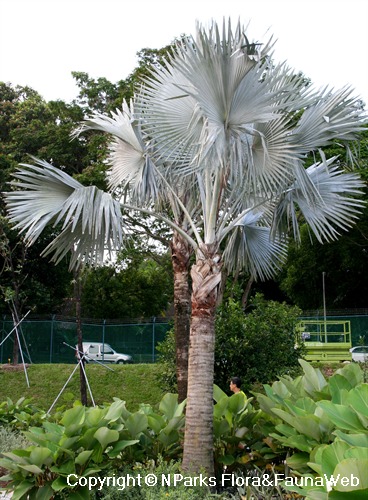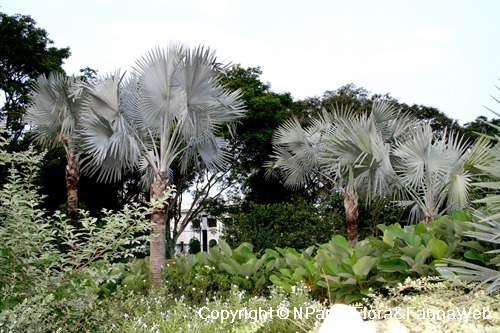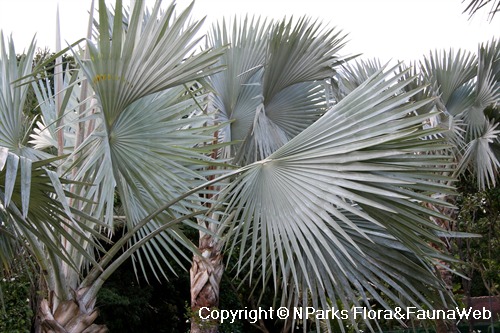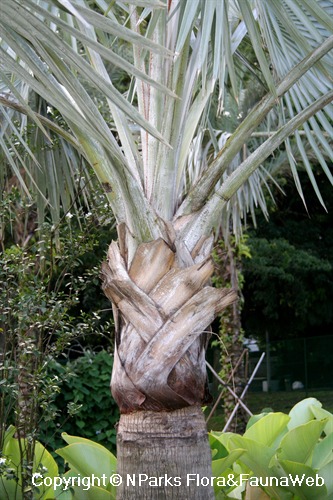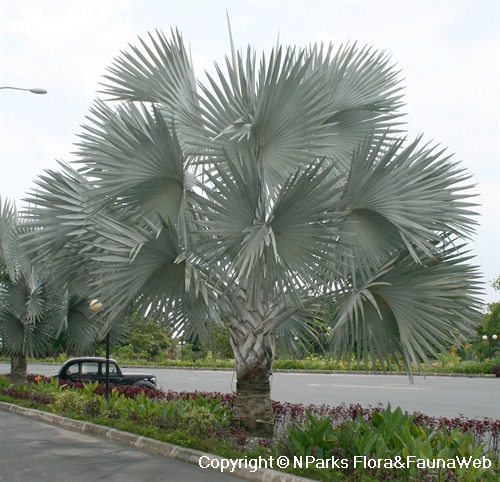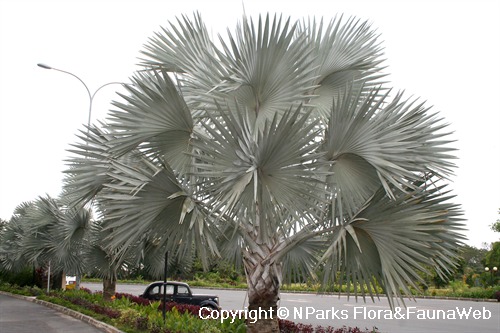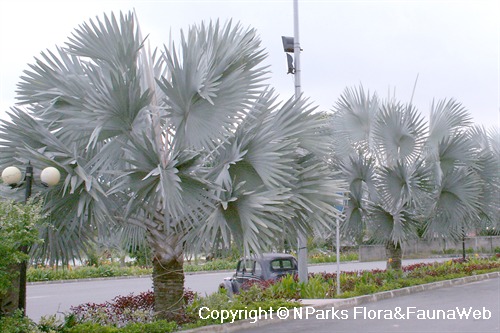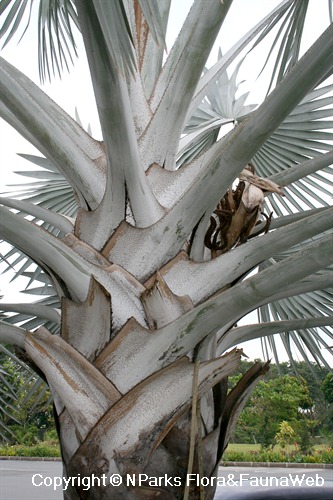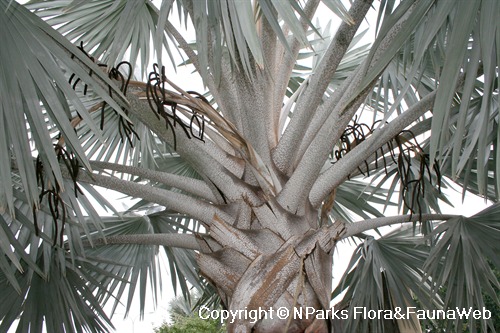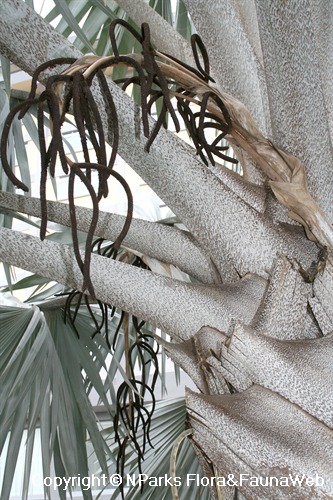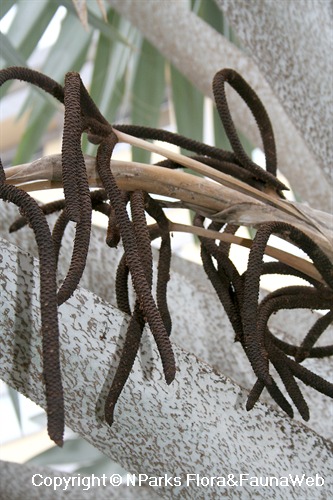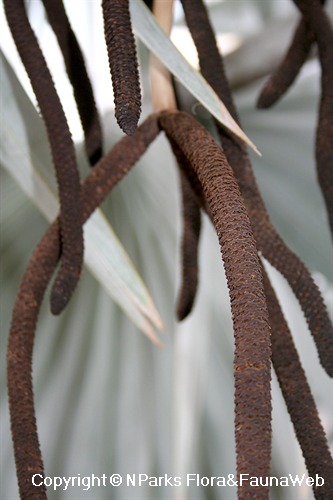
Back
Bismarckia nobilis 'Silver'
| Family Name: | Arecaceae (Palmae) |
| Synonyms: | Medemia nobilis 'Silver', Bismarckia nobilis 'Silver Select' |
| Common Name: | Silver Bismarck Palm |
Bismarckia nobilis, also known as Bismarck Palm, is a solitary-growing palm endemic to Madagascar. It can reach up to 20 m tall and features large, fan-shaped, greyish green leaves that can span up to 1.5 m diameter.
Name
Classifications and Characteristics
| Plant Division | Angiosperms (Flowering Seed Plants) (Monocotyledon) |
|---|---|
| Plant Growth Form | Palm (Solitary Habit) |
| Lifespan (in Singapore) | Perennial |
| Mode of Nutrition | Autotrophic |
| Plant Shape | Fountain (Palm-like) |
| Maximum Height | 6 m to 12 m |
| Maximum Plant Spread / Crown Width | 4 m to 5 m |
Biogeography
| Native Distribution | Madagascar (cultivated) |
|---|---|
| Native Habitat | Terrestrial (Grassland / Savannah/ Scrubland) |
| Preferred Climate Zone | Tropical, Sub-Tropical / Monsoonal |
Description and Ethnobotany
| Growth Form | Solitary palm, 6-12m tall and up to 5m across under cultivation. |
|---|---|
| Trunk | Single, grey, 30-45 cm thick, topped by crownshaft of persistent frond-sheath bases. |
| Foliage | Strikingly silver due to surface-bloom of silver-grey wax, fan-shaped, stiff and large (over 3m across when mature). |
| Flowers | Plant is dioecious (separate male and female plants). Female plants produce inflorescences of small creamy-white flowers. |
| Fruit | Ovoid drupes, single-seeded, produced in large clusters on female palms. Plant not observed to flower and fruit under local conditions, although flowering has been observed in Indonesia (Batam). |
| Cultivation | Heat-loving and drought-tolerant. Prefers well-drained soils. May be attacked by Hispid Beetle which bores through apical shoot, and causes death and eventual collapse of crown. |
| Etymology | Genus epithet 'Bismarckia' named after General Otto von Bismarck (1815-1898), first Chancellor of the German Empire. Genus is monotypic (ie. possessing only 1 species). Species epithet 'nobilis' means 'renowned' or 'famous'. |
Landscaping Features
| Desirable Plant Features | Ornamental Foliage |
|---|---|
| Landscape Uses | General, Suitable for Roadsides, Swimming Poolside, Focal Plant |
| Thematic Landscaping | Silver Garden, Moonlight Garden |
Fauna, Pollination and Dispersal
| Pollination Method(s) | Biotic (Fauna) (Insects (Ant, Beetle, Fly, Thrip, Wasp)) |
|---|
Plant Care and Propagation
| Light Preference | Full Sun |
|---|---|
| Water Preference | Moderate Water, Little Water |
| Plant Growth Rate | Moderate |
| Rootzone Tolerance | Well-Drained Soils, Drought Tolerant |
| Maintenance Requirements | Moderate |
| Diseases | May be prone to bacterial rot in waterlogged soils. Susceptible to crown damage caused by Hispid Beetle. |
| Pest(s) | Associated with |
| Propagation Method | Seed |
| Propagule Establishment Remarks | Seeds take 2-3 months to germinate. |
| Planting Distance | 4 m to 5 m |
Foliar
| Foliage Retention | Evergreen |
|---|---|
| Mature Foliage Colour(s) | Silver / Grey |
| Mature Foliage Texture(s) | Smooth, Thick |
| Foliar Type | Simple / Unifoliate |
| Foliar Arrangement Along Stem | Spiral |
| Foliar Shape(s) | Non-Palm Foliage (Palmate), Palm Fronds (Fan / Costapalmate) |
| Foliar Venation | Parallel |
| Foliar Margin | Palmately Lobed |
| Typical Foliar Area | Megaphyll (>1640.25cm2 ) |
| Leaf Area Index (LAI) for Green Plot Ratio | 2.5 (Palm - Solitary) |
Non - Foliar and Storage
| Trunk Type (Non Palm) | Non Woody |
|---|---|
| Trunk Type (Palm) | Solitary Habit, Aboveground |
| Bark Colour(s) | Grey to tan brown |
| Mature Bark Texture | Smooth |
| Root Type | Underground (Fibrous Root) |
| Specialised Storage Organ(s) | Aboveground |
Floral (Angiosperm)
| Flower & Plant Sexuality | Unisexual Flowers , Dioecious |
| Flower Colour(s) | Cream / Off-White |
|---|
| Flowering Period | Rarely |
| Flowering Opening Time | Time-Independent |
| Flowering Habit | Polycarpic |
Fruit, Seed and Spore
| Mature Fruit Colour(s) | Brown |
|---|---|
| Fruit Classification | Simple Fruit |
| Fruit Type | Indehiscent Dry Fruit , Nut / Nutlet |
Image Repository
Others
| Master ID | 1307 |
|---|---|
| Species ID | 2600 |
| Flora Disclaimer | The information in this website has been compiled from reliable sources, such as reference works on medicinal plants. It is not a substitute for medical advice or treatment and NParks does not purport to provide any medical advice. Readers should always consult his/her physician before using or consuming a plant for medicinal purposes. |

